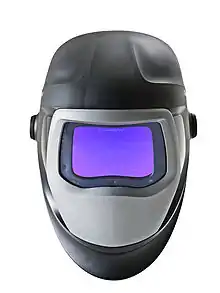Welding helmet
A welding helmet is a type of headgear used when performing certain types of welding to protect the eyes, face and neck from flash burn, ultraviolet light, sparks, infrared light, and heat.
Welding helmets are most commonly used with arc welding processes such as shielded metal arc welding, gas tungsten arc welding, and gas metal arc welding. They are necessary to prevent arc eye, a painful condition where the cornea is inflamed. Welding helmets can also prevent retina burns, which can lead to a loss of vision. Both conditions are caused by unprotected exposure to the highly concentrated ultraviolet and infrared rays emitted by the welding arc.[1] Ultraviolet emissions from the welding arc can also damage uncovered skin, causing a sunburn-like condition in a relatively short period of welding. In addition to the radiation, gasses or splashes can also be a hazard to the skin and the eyes.[2]
The modern welding helmet used today was first introduced in 1937 by Willson Products.[3]
Most welding helmets include a window covered with a filter called a lens shade, through which the welder can see to work. In most helmets, the window may be made of tinted glass, tinted plastic, or a variable-density filter made from a pair of polarized lenses. Different lens shades are needed for different welding processes. For example MIG and TIG welding are low-intensity processes, so a lighter lens shade will be preferred.
Safety
All welding helmets are susceptible to damages such as cracks that can compromise the protection from ultraviolet and infrared rays. In addition to protecting the eyes, the helmet protects the face from hot metal sparks generated by the arc and from UV damage. When overhead welding, a leather skull cap and shoulder cover are used to prevent head and shoulder burns.[4]
Auto-darkening filters

In 1981, Swedish manufacturer Hornell International introduced an LCD electronic shutter that darkens automatically when sensors detect the bright welding arc,[5][6] the Speedglas Auto-Darkening Filter.
With such electronic auto-darkening helmets, the welder no longer has to get ready to weld and then nod their head to lower the helmet over their face. The advantage is that the welder does not need to adjust the position of welding helmet manually which not only saves time but also reduces the risk of exposure to the harmful light generated by the welding process.
In January 2004, 3M acquired all assets of Hornell, including the Adflo and Speedglas auto darkening helmets brand name and patents. Speedglas helmets are now sold by 3M.[7]
ANSI standards
In the United States, the industry standard for welding helmets is ANSI Z87.1+ which specifies performance of a wide variety of eye protection devices. The standard requires that auto-darkening helmets provide full protection against both UV and IR even when they are not in the darkened state.[6] The standard is voluntary, so buyers should confirm that the helmet is ANSI Z87.1 compliant (indicated by appropriate labeling).
See also
- Welding goggles, used in torch welding
Notes
- Elvex Safety Products How Light Affects the Eye
- "Testbericht zur Automatik-Schweißmaske Speedglas 100 von 3M". Testberichte für Testsieger (in German). 2017-01-12. Retrieved 2017-01-29.
- "One Piece Helmet Cut To Protect The Welder Popular Mechanics, August 1937 -- bottom-left of page 217
- Miller, Mark R. (2007), Welding Licensing Exam Study Guide, McGraw-Hill Professional, p. 5, ISBN 978-0-07-149376-5.
- "Welding Safety - PPE - 3M Worker Health & Safety - 3M United States". www.3m.com.
- "Technische Entwicklung automatischer Schweißerschutzfilter". Testberichte für Testsieger (in German). 2017-01-19. Retrieved 2017-01-29.
- "3M to Acquire Hornell International: Expands Safety Products Line". 3M News - United States.
Further reading
- Jeffus, Larry (1999). Welding: Principles and Applications. Albany: Thomson Delmar. ISBN 0-8273-8240-5 .
